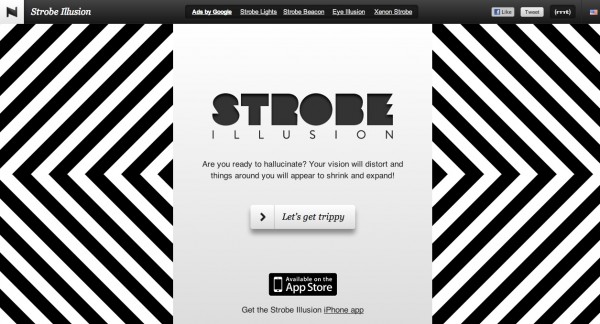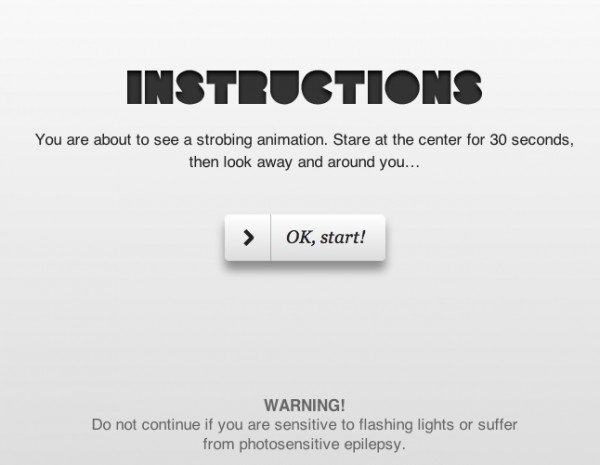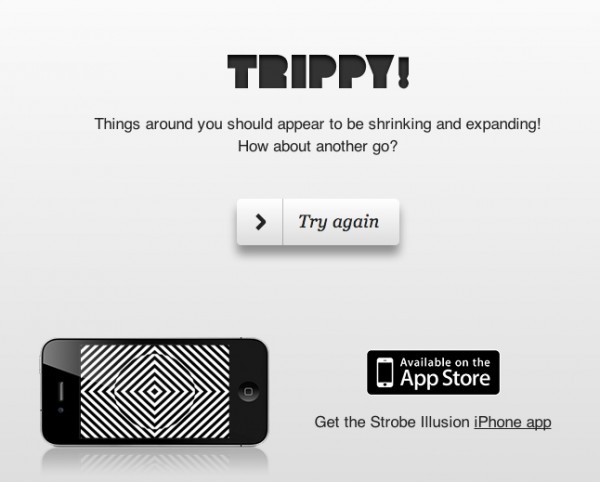“Life should not be a journey to the grave with the intention of arriving safely in a pretty and well preserved body, but rather to skid in broadside in a cloud of smoke, thoroughly used up, totally worn out, and loudly proclaiming, 'Wow! What a Ride!'” -Hunter S. Thompson
For those of you who've never experienced exactly what it feels like to alter your perceptions, and for those of you who have but don't want to spend hours and hours experiencing the effects, your options have traditionally been limited. Perhaps a song might provide a window into the experience for you, such as M. Ward's
But thanks to the combined power of technology and our understanding of neuroscience (and perception), a simple visual pattern can induce temporary (lasting less than a minute) hallucinations, safely and temporarily.

The Strobe Illusion; screen capture from http://neave.com/strobe/.
The website Neave.com has put together a way -- simply by staring at a moving pattern on your screen -- to induce distorted, hallucinatory vision in people!

The Strobe Illusion; screen capture from http://neave.com/strobe/.
They warn you that if you are sensitive to flashing lights or suffer from photosensitive epilepsy, you should avoid this. To go experience it yourself at their site, just click here. But I couldn't resist trying to do it myself, and make a video that I could directly embed into this post.
To make it work, just full-screen it, move your face close to the screen and stare at the center. When the video ends (it's only 40 seconds long), look anyplace else and enjoy your distorted, hallucinatory vision for under a minute!

The Strobe Illusion; screen capture from http://neave.com/strobe/.
Once again, check out the original here, and hope you enjoyed this safe, simple (and legal) way to enjoy a little mind-bending this weekend. However you spend the rest of it, hope it's a great one!

Am I the only one who clicked on the Jpg files?
"and for those of you who have but don’t want to spend hours and hours experiencing the effects" - DMT is for you! :P
Here are a few more you can safely try:
1) Bring up an area of white screen on your computer. Sit at a distance such that you can let your eyes defocus and wander in the same manner as when viewing the type of 3D pictures that depend on a particular type of defocused viewing. The tiny rectangles that are the pixels on the screen will start to become the basis of moire patterns. If you do this while sleep-deprived and tired, the patterns will show light colors and become somewhat similar to the color patterns reflected from a sheen of oil on the surface of water.
2) Very gently press your fingers on the corners of your eyes (wash your hands first) in a dark room. Shortly you will start to see increasingly complex geometric patterns in deep colors.
3) Lie down in a dark room and balance one forearm vertically at your elbow. This position requires almost no effort to maintain. Let yourself drift toward sleep. If you cross over the line to actual sleep, your arm will fall over and wake you up. By this means you can keep yourself at the borderline of sleep, where you may encounter the "hypnagogic state," that is characterised by richly colored images from simple geometries to complex and detailed visions of realistic or wholly imaginal content. The imagery in this state is truly as good as anything that can be produced via the administration of n-n-dimethyltryptamine, without the hassles of applying for FDA permits or risking illicit use, and there are no risks of unpleasant cognitive effects.
4) Keep a journal of your dreams. At first this may seem uninteresting, but over time you will begin to notice interesting things about the contents of dreams: persons and objects, contexts, "dream logic" that differs from waking logic, and so on. The best available science today says that dreams are either the brain's pattern-seeking capability applied to convert random neural "noise" into stories, or are a side-effect of the consolidation of other cognitive content into memory. Over time you may see indications of either of these phenomena. The best way to record dreams is to do it immediately after you wake up, otherwise the memory of dream content will remain state-specific.
5) At random intervals during the day, ask yourself "what state of consciousness am I in, and how do I know?" Make this a regular practice so you do it out of habit. At some point the habit will carry over into your dream state, and there's a good chance it will result in lucid dreams (wherein you can act consciously and willfully). One of the most common things that people do in lucid dreams is leap into the air and fly: expressing an ancient and widespread human desire. (An interesting question: is that desire hardwired in the brain or does it arise from learning common cultural memes, or some combination of both?)
@davem: Yes
maybe i can use this to get the hippies to stop trampling my mushrooms.
Ethan
Thanks
G
Thanks
Knowing how our mind works and how it biases our perception is fun and interesting. If we don't know our dozens of mental states (actively observing them) versus just intellectually "understanding"; then what do we mean when we say that we know ourself. From blind spot awareness to dream states, illusions, to hallucination, to mental proprioception, to etc..
(Thanks, OKThen;-)
Altered states have practical value as means of getting new perspectives on whatever subject-matter one might be concerned with. Examples include Kekule's insight into the structure of the benzene ring (from a hypnagogic hallucination), Crick's insight into the structure of the DNA molecule (from a then-legal LSD trip under psychiatric supervision), and numerous instances of artistic works inspired with the aid of alcohol, cannabis, etc. Even the "release of effort effect," of deliberately shifting attention away from a task, has led to useful insights such as mathematical proofs (one of which was recently described on ScienceBlogs).
Here is a key point: altered states do not need to be extreme or emotional in order to provide the benefits of new perspectives. The hypnagogic state is extremely common (and usually forgotten during the course of sleep). Dreaming is universal. Meditation and contemplation can be utilized without buying into various religious premises. Recent findings in neuroscience may be used to develop new exercises for inducing subtle altered states with useful characteristics.
Arguably, simple stillness of mind is the most useful "baseline" state from which to engage in rational thought, free of emotional biases and subjective drives.
The relevant exercise is to sit still in a quiet room that is not brightly lit, close your eyes, and direct your attention to your breathing (it may help to count your breaths from one to ten and repeat, just to provide a neutral verbal/numeric task). Whenever any other content comes to mind, such as any other thought or emotion, gently return your attention to your breathing.
Even ten minutes of this, twice a day, should be sufficient to provide a state of stillness that can be used as a point of reference for thinking clearly and rationally.
It will also make clear over time, that much of what we consider rational thought is actually emotionally-driven rationalization: a strong feeling or bias comes first, and the "rational" steps are filled in (or argued to others) as if to "explain" it. Those of us with an interest in promoting rationalism as a philosophical paradigm, would do well to become acquainted with stillness of mind as a baseline state.
Altered states only really give you insight into how you can fool yourself or your senses.
Quite useful to help you regain a sense of perspective. But very much like watching a really good illusionist.
G
Very well said.
Yes, yes. We do fool ourselves quite often. The sometimes necessary illusions. Starting with such common practices as not really knowing how we feel.
"How you doing Joe?"
"Absolutely great, best day of my life."
"You're the best Joe. always great talking to you."
Of course exchanging attaboys between friends is good; but there needs to be more in relationship and understanding and arts and science.
Let me give a personal example of being out of touch with myself.
I use to come home from work and not know how I really was feeling. I would then sit down at the piano and just make up music, improvise. And in the act of playing, I got in touch with how I felt and how my day had gone. Through music I got in touch with my anger, happiness, sadness and curiousity. It was only after I played my piano (now a synthesizer) that I was able to un-repress and acknowledge how I was really feeling about my work (e.g. really pissed off or quite proud).
It is much better (in my opinion) to know how I really feel (even if terribly sad or disappointed) than to pretend that I am having the best day of my life. Yes, I may put on my best face to the world; but I need to be honest with myself, know how I feel. I also believe that it is important to be as honest in relations as I can be and as they can accept.
And feelings aren't just about emotional things, arts, music; they are also about the so-called rational things too e.g. math, science, economics, business activity. Risk taking requires emotional confidence as well as clear reasoning.
For example, how does a young scientist make a research decision about where to spend his most valued resource (his time and career). And will his personal best research years prove a theory, create a new riddle or prove to be a waste of time? Where does intelligent focus come from? Can it be achieved? And then can it be clear minded and persistent enough to convince and persistent enough to re-convince the necessary funding authorities and other researchers etc...
"Dr. Everitt, .. joined the Gravity Probe experiment in 1962 as a young postdoctoral fellow and has worked on nothing else since... The experiment was conceived in 1959, but the technology to make these esoteric measurements did not yet exist, which is why the experiment took so long and cost so much. The gyroscopes, for example, were made of superconducting niobium spheres, the roundest balls ever manufactured, which then had to be flown in a lead bag to isolate them from any other influences in the universe, save the subversive curvature of space-time itself... Dr. Francis said the project had been canceled at least seven times, “depending on what you mean by canceled.” It was finally sent into orbit in 2004 and operated for some 17 months, but not all went well. When the scientists began analyzing their data, they discovered that patches of electrical charge on the niobium balls had generated extra torque on the gyroscopes, causing them to drift... It would take five more years to understand the spurious signals and retrieve the gravity data by dint of an effort that Dr. Will called “nothing less than heroic.” .. the NASA grant ran out. Dr. Everitt secured another one from Richard Fairbank, a financier and son of one of the experiment’s founders, William Fairbank, that was matched by NASA and Stanford. When that ran out and NASA turned him down for a new grant, Dr. Everitt obtained a $2.7 million grant from Turki al-Saud, a Stanford graduate and vice president for research institutes at the King Abdulaziz City for Science and Technology in Saudi Arabia."
Kudoos Dr. Everitt on your amazing focus.
In my opinion "knowing yourself"; plays significant part in creative arts and sciences. "Knowing yourself" and "your ideas" means being willing to question everything, no authority is to big and no detail is to small to be challenged and questioned.
Ultimately, understanding our "ideas", our "self", and our "universe" is the same thing; and impossible without a clear mind.
If we suffer from "the illusion of knowing" (anything); then we will not dare to question, to learn and to discover a new idea or insight about our self or our universe. All knowledge is fragmentary, incomplete, tentative (NOT complete); with that humble understanding we can be open to the unknown and dare to discover.
By the way> I think there needs to be more comedy about science. Comedy is often the best way to question authority and not lose your head (as court jesters of old were well aware).
Yes, yes, I am quite serious. Neither Carl Sagan nor ethan Seigel make anough jokes about the universe. this is my seque to some standard model comments.
OKThen- Excellent on all counts!
Your point about using music practice & improvisation to get in touch with your emotional state is brilliant. It's valuable in and of itself both for artistic reasons (if you do any recording or performing) and for psychological reasons (authenticity and recognition of your actual state of mind). And it's valuable for becoming aware of emotions that influence thoughts and attitudes, the better to offset one's own objectivity-compromises.
Dr. Everitt and the gravity probe is a great lesson in the benefits of maintaining focus on long-term goals. It's also a lesson in the need for a vast increase in public funding for science, with projects funded in their entirety from the outset, so scientists don't have to waste time begging for money every few years. But for every person who succeeds like that, there are dozens who can't get the resources to finish their work, and humanity as a whole suffers from the delays in learning about our universe.
"Knowing oneself" and "questioning one's ideas," are core elements of being able to think outside the box: and that's where a lot of useful insights & hypotheses come from. All of this can be learned, and can be improved with practice. Exercises such as sitting still and concentrating on a neutral stimulus, or doing music improv or other artistic activities, are all good for developing cognitive flexibility.
I have had the following experience twice:
I was having a frightening dream and became aware that I was dreaming. I wanted to wake up, but I couldn't. I tried to control the dream, and couldn't. I started feeling trapped in this very scary experience, and tried to yell out "Somebody, wake me up, wake me up...."
I was in sleep paralysis, and couldn't enunciated the words much at all, but I was trying to scream them loud. I guess it sounded like a banshee, I imagine, and both times I came awake to "Mike, Mike, wake up, you're having a bad dream."
Actually, it's happened along those lines a few times when I was alone, and I remember the noise actually waking me up.
Immediately upon waking, I knew that I was awake, my surroundings were real. It's such a contrast, but still the sense of the dream being the true reality took, I don't know, perhaps up to a few minutes to subside.,
This is, by far, the weirdest experiences I have had. I have had a few lucid dreaming events, but I could never direct the course of the dreams, or the events as they were happening! Damn it, I though were supposed to able to!
I got a headache, little bit like a hangover after doing it few times in a row. It must be exhausting to my brain. And I also had a little bit blured vision for a while.
The scare of having to run away but being unable to is a result of sleep paralysis meaning you want to move your legs, but are awake enough to feel they aren't moving.
When a young kid, I used to JUMP streets to "run away" from whatever was chasing me. You don't move your legs much to jump in your dreams.
Worked wonders.
I don't like illusions!!!!!!!!
No. Didn't work. You liar.
these work... i guesse but dont last long enough